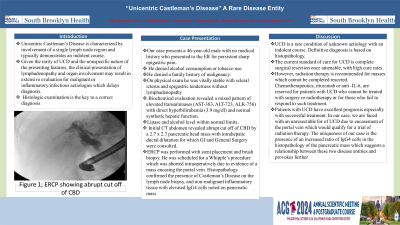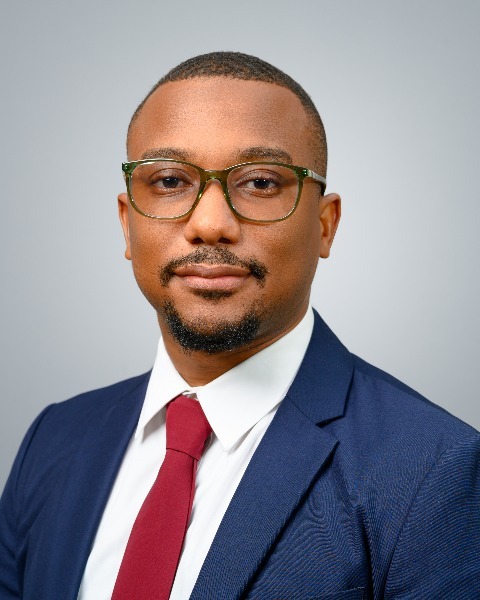Sunday Poster Session
Category: Biliary/Pancreas
P0166 - Unicentric Castleman Disease: A Case Report on a Rare Disease Entity
Sunday, October 27, 2024
3:30 PM - 7:00 PM ET
Location: Exhibit Hall E

Has Audio

Akil Olliverrie, MD
NYC Health + Hospitals/South Brooklyn Health
Brooklyn, NY
Presenting Author(s)
Akil Olliverrie, MD, Syed Karim, DO, Mohammad Chowdhary, MD, Thomas mcIntyre, MD, Sushant Remersu, MD
NYC Health + Hospitals/South Brooklyn Health, Brooklyn, NY
Introduction: Unicentric Castleman’s Disease is characterized by involvement of a single lymph node region and typically demonstrates an indolent course. Given the rarity of UCD and the nonspecific nature of the presenting features, the clinical presentation of lymphadenopathy and organ involvement may result in extensive evaluation for malignant or inflammatory/infectious aetiologies which delays diagnosis. Histologic examination is the key to a correct diagnosis.
Case Description/Methods: Our case presents a 46-year-old male with no medical history who presented to the ER for persistent sharp epigastric pain. He denied alcohol consumption or tobacco use. He denied a family history of malignancy. On physical exam he was vitally stable with scleral icterus and epigastric tenderness without lymphadenopathy.Biochemical evaluation revealed a mixed pattern of elevated transaminases (AST-383, ALT-723, ALK-756) with direct hyperbilirubemia (3.9 mg/dl) and normal synthetic hepatic function. Lipase and alcohol level within normal limits. Initial CT abdomen revealed abrupt cut off of CBD by a 2.7 x 2.7 pancreatic head mass with intrahepatic ductal dilatation for which GI and General Surgery were consulted. ERCP was performed with stent placement and brush biopsy. He was scheduled for a Whipple’s procedure which was aborted intraoperatively due to evidence of a mass encasing the portal vein. Histopathology confirmed the presence of Castleman’s Disease on the lymph node biopsy, and non-malignant inflammatory tissue with elevated IgG4 cells noted on pancreatic mass.
Discussion: UCD is a rare condition of unknown aetiology with an indolent course. Definitive diagnosis is based on histopathology. The current standard of care for UCD is complete surgical resection once amenable, with high cure rates. However, radiation therapy is recommended for masses which cannot be completed resected. Chemotherapeutics, rituximab or anti–IL-6, are reserved for patients with UCD who cannot be treated with surgery or radiotherapy or for those who fail to respond to such treatment. Patients with UCD have excellent prognosis especially with successful treatment. In our case, we are faced with an unresectable for of UCD due to encasement of the portal vein which would qualify for a trial of radiation therapy. The uniqueness of our case is the presence of an increased ratio of IgG4 cells in the histopathology of the pancreatic mass which suggests a relationship between these two disease entities and provokes further investigation.
Disclosures:
Akil Olliverrie, MD, Syed Karim, DO, Mohammad Chowdhary, MD, Thomas mcIntyre, MD, Sushant Remersu, MD. P0166 - Unicentric Castleman Disease: A Case Report on a Rare Disease Entity, ACG 2024 Annual Scientific Meeting Abstracts. Philadelphia, PA: American College of Gastroenterology.
NYC Health + Hospitals/South Brooklyn Health, Brooklyn, NY
Introduction: Unicentric Castleman’s Disease is characterized by involvement of a single lymph node region and typically demonstrates an indolent course. Given the rarity of UCD and the nonspecific nature of the presenting features, the clinical presentation of lymphadenopathy and organ involvement may result in extensive evaluation for malignant or inflammatory/infectious aetiologies which delays diagnosis. Histologic examination is the key to a correct diagnosis.
Case Description/Methods: Our case presents a 46-year-old male with no medical history who presented to the ER for persistent sharp epigastric pain. He denied alcohol consumption or tobacco use. He denied a family history of malignancy. On physical exam he was vitally stable with scleral icterus and epigastric tenderness without lymphadenopathy.Biochemical evaluation revealed a mixed pattern of elevated transaminases (AST-383, ALT-723, ALK-756) with direct hyperbilirubemia (3.9 mg/dl) and normal synthetic hepatic function. Lipase and alcohol level within normal limits. Initial CT abdomen revealed abrupt cut off of CBD by a 2.7 x 2.7 pancreatic head mass with intrahepatic ductal dilatation for which GI and General Surgery were consulted. ERCP was performed with stent placement and brush biopsy. He was scheduled for a Whipple’s procedure which was aborted intraoperatively due to evidence of a mass encasing the portal vein. Histopathology confirmed the presence of Castleman’s Disease on the lymph node biopsy, and non-malignant inflammatory tissue with elevated IgG4 cells noted on pancreatic mass.
Discussion: UCD is a rare condition of unknown aetiology with an indolent course. Definitive diagnosis is based on histopathology. The current standard of care for UCD is complete surgical resection once amenable, with high cure rates. However, radiation therapy is recommended for masses which cannot be completed resected. Chemotherapeutics, rituximab or anti–IL-6, are reserved for patients with UCD who cannot be treated with surgery or radiotherapy or for those who fail to respond to such treatment. Patients with UCD have excellent prognosis especially with successful treatment. In our case, we are faced with an unresectable for of UCD due to encasement of the portal vein which would qualify for a trial of radiation therapy. The uniqueness of our case is the presence of an increased ratio of IgG4 cells in the histopathology of the pancreatic mass which suggests a relationship between these two disease entities and provokes further investigation.
Disclosures:
Akil Olliverrie indicated no relevant financial relationships.
Syed Karim indicated no relevant financial relationships.
Mohammad Chowdhary indicated no relevant financial relationships.
Thomas mcIntyre indicated no relevant financial relationships.
Sushant Remersu indicated no relevant financial relationships.
Akil Olliverrie, MD, Syed Karim, DO, Mohammad Chowdhary, MD, Thomas mcIntyre, MD, Sushant Remersu, MD. P0166 - Unicentric Castleman Disease: A Case Report on a Rare Disease Entity, ACG 2024 Annual Scientific Meeting Abstracts. Philadelphia, PA: American College of Gastroenterology.
